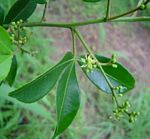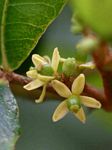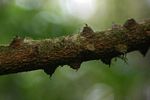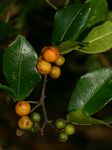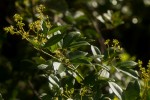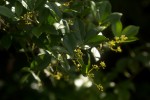Toddalia asiatica
Selected images: Click on each image to see a larger version and details of the record View all images (16)
Detailed records: Display species records QDS maps by: Google Maps Point records by Google Maps
Species details: Click on each item to see an explanation of that item (Note: opens a new window)
| Synonyms: |
Toddalia aculeata Pers. Zanthoxylum asiaticum (L.) Appelhans, Groppo & J.Wen |
| Common names: | Chikafusi (Shona) Climbing orange (English) Cockspur orange (English) Gato (Shona) Mubhatakhamba (Ndau) Rukato (Shona) |
| Frequency: | Common in the E Highlands |
| Status: | Native |
| Description: |
Strong robust liane. The young branches are covered with sharp, hooked thorns. In older branches these form thickened knobs, which still maintain the hooks. Leaves 3-foliolate; leaflets elliptic to obovate, shiny green, paler below, covered with translucent gland-dots, with a strong citrus smell when crushed. Flowers in axillary and terminal clusters or branched inflorescences, cream to pale greenish-yellow. Fruit small, citrus-like, orange when ripe. |
| Type location: |
Syntypes from India |
| Notes: | The status of this record from the Central Division is discussed in Note 1. |
| Derivation of specific name: | asiatica: of Asia |
| Habitat: | In evergreen forest and riverine forest margins, often climbing into the canopy of larger trees. |
| Altitude range: (metres) | 1100 - 1730 m |
| Flowering time: | Sep - Jan |
| Worldwide distribution: | Africa from East and Central Africa southwards to South Africa, Madagascar, the Mascarene Islands and India |
| FZ divisions: | C,E,S |
| Growth form(s): | Climber, liane. |
| Endemic status: | |
| Red data list status: | |
| Insects associated with this species: | Papilio dardanus cenea (Food plant) Papilio demodocus demodocus (Food plant) Papilio nireus lyaeus (Larval foodplant) |
| Spot characters: | Display spot characters for this species |
| Images last updated: | Thursday 14 June 2018 |
| Literature: |
Burrows, J.E. & Willis, C.K. (eds) (2005). Plants of the Nyika Plateau Southern African Botanical Diversity Network Report No. 31 SABONET, Pretoria Page 256. (Includes a picture). Burrows, J.E., Burrows, S.M., Lötter, M.C. & Schmidt, E. (2018). Trees and Shrubs Mozambique Publishing Print Matters (Pty), Cape Town. Page 352. (Includes a picture). Chapano, C. & Mamuto, M. (2003). Plants of the Chimanimani District National Herbarium and Botanic Garden, Zimbabwe Page 55. Dowsett-Lemaire, F. (1989). The flora and phytogeography of the evergreen forests of Malawi. I: Afromontane and mid-altitude forests; Bull. Jard. Bot. Nat. Belg. 59(1/2) Page 24. Drummond, R.B. (1975). A list of trees, shrubs and woody climbers indigenous or naturalised in Rhodesia. Kirkia 10(1) Page 248. Mapaura, A. & Timberlake, J. (eds) (2004). A checklist of Zimbabwean vascular plants Southern African Botanical Diversity Network Report No. 33 Sabonet, Pretoria and Harare Page 75. Mendonça, F. A. (1963). Rutaceae Flora Zambesiaca 2(1) Page 199. Ntore, S. & al. (2024). Checklist of the vascular plants of Burundi Page 230. Siebert, S. & Mössmer, M. (Editors) (2002). SABONET Southern Mozambique Expedition 2001; Provisional Plant Checklist of the Maputo Elephant Reserve (MER) and Licuati Forest Reserve (LFR) SABONET News 7(1) Page 29. Steedman, E.C. (1933). Some Trees, Shrubs and Lianes of Southern Rhodesia. Page 29. (Includes a picture). Strugnell, A.M. (2006). A Checklist of the Spermatophytes of Mount Mulanje, Malawi Scripta Botanica Belgica 34 National Botanic Garden of Belgium Page 171. Timberlake, J.R., Bayliss, J., Dowsett-Lemaire, F., Congdon, C., Branch, B., Collins, S., Curran, M., Dowsett, R,J., Fishpool, L., Francisco, J., Harris, Kopp, M. & de Sousa, C. (2012). Mt Mabu, Mozambique: Biodiversity and Conservation Report produced under the Darwin Initiative Award 15/036. Royal Botanic Gardens, Kew, London Page 75. Wursten, B., Timberlake, J. & Darbyshire, I. (2017). The Chimanimani Mountains: an updated checklist. Kirkia 19(1) Page 99. |
Other sources of information about Toddalia asiatica:
Our websites:
Flora of Burundi: Toddalia asiaticaFlora of Malawi: Toddalia asiatica
Flora of Mozambique: Toddalia asiatica
Flora of Zambia: Toddalia asiatica
External websites:
African Plants: A Photo Guide (Senckenberg): Toddalia asiaticaAfrican Plant Database: Toddalia asiatica
BHL (Biodiversity Heritage Library): Toddalia asiatica
EOL (Encyclopedia of Life): Toddalia asiatica
GBIF (Global Biodiversity Information Facility): Toddalia asiatica
Google: Web - Images - Scholar
iNaturalist: Toddalia asiatica
IPNI (International Plant Names Index): Toddalia asiatica
JSTOR Plant Science: Toddalia asiatica
Mansfeld World Database of Agricultural and Horticultural Crops: Toddalia asiatica
Plants of the World Online: Toddalia asiatica
Tropicos: Toddalia asiatica
Wikipedia: Toddalia asiatica
